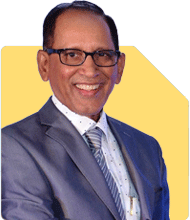Patrick Dsouza |1288 Answers |Ask -Follow
CAT, XAT, CMAT, CET Expert - Answered on Feb 21, 2024
Along with his wife, Rochelle, he trains students for competitive management entrance exams such as the Common Admission Test, the Xavier Aptitude Test, Common Management Admission Test and the Common Entrance Test.
They also train students for group discussions and interviews.
Patrick has scored in the 100 percentile six times in CAT. He achieved the first rank in XAT twice, in CET thrice and once in the Narsee Monjee Management Aptitude Test.
Apart from coaching students for MBA exams, Patrick and Rochelle have trained aspirants from the IIMs, the Jamnalal Bajaj Institute of Management Studies and the S P Jain Institute of Management Studies and Research for campus placements.
Patrick has been a panellist on the group discussion and panel interview rounds for some of the top management colleges in Mumbai.
He has graduated in mechanical engineering from the Motilal Nehru National Institute of Technology, Allahabad. He has completed his masters in management from the Jamnalal Bajaj Institute of Management Studies, Mumbai.... more

Dear sir,I am compulsory retired from psu, as a senior Manager still I am having 5 years For matured retirement. Is there any jobs available for me?
R P Yadav | Answer |Ask -Follow
HR, Workspace Expert - Answered on Feb 23, 2024
Over the years, he has been the recipient of numerous awards including the Lifetime Achievement Award from World HR Congress and HR Person Of The Year from Public Relations Council of India.
... more

Dear sir,I am compulsory retired from psu, as a senior Manager still I am having 5 years For matured retirement. Is there any jobs available for me?
Industry Consultancy: Consider offering consultancy services in your industry. Your extensive experience can be valuable to companies seeking expertise in areas such as operations management, strategic planning, or process optimization.
Freelancing or Contract Work: Explore opportunities for freelancing or contract work in your field. Many companies, especially startups or smaller businesses, may require temporary support for specific projects or initiatives.
Part-Time or Remote Work: Look for part-time or remote work opportunities that allow for flexibility and work-life balance. Many organizations offer remote positions for experienced professionals, including roles in project management, consulting, or advisory services.
Government or NGO Roles: Investigate opportunities in government agencies or non-governmental organizations (NGOs) where your experience and expertise can be beneficial. These organizations often have positions available in areas such as policy development, program management, or capacity building.
Teaching or Training: Consider sharing your knowledge and expertise by pursuing opportunities in teaching or training roles. Universities, colleges, training institutes, and corporate training departments may seek experienced professionals to teach courses or conduct workshops in your field.
Professional Associations and Networks: Join professional associations and networks related to your industry. These platforms can provide access to job opportunities, networking events, and professional development resources.
Entrepreneurship: Explore the possibility of starting your own business or venture based on your expertise and interests. Entrepreneurship allows you to leverage your experience to create innovative solutions or services within your industry.
Career Counseling and Coaching: With your extensive experience, you could consider a career in counseling or coaching, helping individuals navigate their career paths, develop skills, and achieve their professional goals.
Online Platforms: Utilize online job platforms, networking sites like LinkedIn, and specialized recruitment agencies to explore job opportunities tailored to your skills and experience.
Upskilling and Continuous Learning: Stay updated with industry trends, technologies, and best practices through continuous learning and upskilling. Investing in certifications, attending workshops, or pursuing advanced education can enhance your marketability and open doors to new opportunities.
Remember to tailor your job search approach to your interests, strengths, and career goals. Networking, maintaining a strong online presence, and staying proactive in your job search efforts can significantly increase your chances of finding fulfilling opportunities in your mature retirement phase.
Nitin Narkhede |89 Answers |Ask -Follow
MF, PF Expert - Answered on Jul 13, 2025
Nitin Narkhede |89 Answers |Ask -Follow
MF, PF Expert - Answered on Jul 13, 2025
Radheshyam Zanwar |5298 Answers |Ask -Follow
MHT-CET, IIT-JEE, NEET-UG Expert - Answered on Jul 13, 2025
Radheshyam Zanwar |5298 Answers |Ask -Follow
MHT-CET, IIT-JEE, NEET-UG Expert - Answered on Jul 13, 2025
Radheshyam Zanwar |5298 Answers |Ask -Follow
MHT-CET, IIT-JEE, NEET-UG Expert - Answered on Jul 13, 2025
Radheshyam Zanwar |5298 Answers |Ask -Follow
MHT-CET, IIT-JEE, NEET-UG Expert - Answered on Jul 13, 2025
Radheshyam Zanwar |5298 Answers |Ask -Follow
MHT-CET, IIT-JEE, NEET-UG Expert - Answered on Jul 13, 2025
Radheshyam Zanwar |5298 Answers |Ask -Follow
MHT-CET, IIT-JEE, NEET-UG Expert - Answered on Jul 13, 2025
Radheshyam Zanwar |5298 Answers |Ask -Follow
MHT-CET, IIT-JEE, NEET-UG Expert - Answered on Jul 13, 2025
Radheshyam Zanwar |5298 Answers |Ask -Follow
MHT-CET, IIT-JEE, NEET-UG Expert - Answered on Jul 13, 2025

















